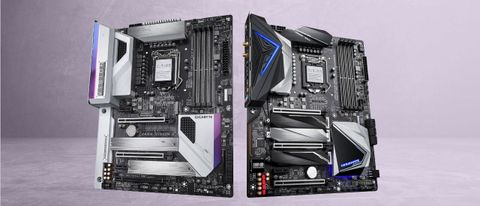Tom's Hardware Verdict
Both of these Creator-focused boards from Gigabyte are solid foundations for building a Z490-based system. The Vision D is more of a ‘true’ creator board, with its Thunderbolt ports and display flexibility, among other features. But the Vision G isn’t a slouch, either.
Pros
- +
10 USB Ports
- +
Sufficient power delivery
- +
Premium Audio codec
- +
2.5 GbE
- +
Vision D has AX200 Wi-Fi, Thunderbolt 3
Cons
- -
Looks may not be for everyone
- -
Vision G is purpose agnostic
Why you can trust Tom's Hardware
In addition to the high-level specs, both boards provide six SATA ports and a slew of USB connectivity on the rear IO. One other difference between these two outside of price, looks is the integrated Wi-Fi and Thunderbolt 3 connectivity: The Vision D has three M.2 slots, while the Vision G has two. Before we get to a detailed look at layout and performance, below is a complete list of specifications on both motherboards, from Gigabyte.
Motherboard makers are coming up with some innovative ways to distinguish their motherboard product lines. From overclocking series to creator boards, each company has something different, including Gigabyte, with its creator-focused Vision brand of boards. Here we’re covering the Intel side of the lineup, with the Z490 Vision D ($289.99) and Z490 Vision G ($199.99). As usual, we’ll be comparing their hardware, included features and performance, to see which motherboard is better for the creator these boards are designed for.
Gigabyte states its Vision line offers “...a no-compromise platform that excels in performance, functionality, and stability… paving the way for creators to work faster and efficiently...” The Vision D is higher up the product stack than the Vision G, bringing more features to the table including integrated Wi-Fi, Thunderbolt 3 ports, and RGB lighting. The Vision G, on the other hand, is priced about $90 less and doesn’t include the features mentioned in the previous sentence. Outside of that, both motherboards offer users solid power delivery, premium integrated audio, and more.
Performance between these two boards in our tests was nearly indistinguishable, as we would expect. Both have the same power delivery and utilize the same behavior for Intel boost. Compared to other boards, our Vision samples also mixed in well with the competition. Overclocking went well, with both able to take our Intel Core i9-10900K to 5.2 GHz and memory to DDR4 4000 speeds without issue. The VRMs ran a bit warm, but still well within operating parameters.
Specifications - Gigabyte Z490 Vision D and Vision G
| Header Cell - Column 0 | Vision D | Vision G |
|---|---|---|
| Socket | LGA 1200 | LGA 1200 |
| Chipset | Z490 | Z490 |
| Form Factor | ATX | ATX |
| Voltage Regulator | 13 Phase (12+1) 50A MOSFETs | 13 Phase (12+1) 50A MOSFETs |
| Video Ports | (1) HDMI (v1.4) | (1) HDMI (v1.4) |
| Row 5 - Cell 0 | (1) DisplayPort (input) | (1) DisplayPort (input) |
| Row 6 - Cell 0 | (2) Thunderbolt 3 (USB Type-C) | (2) Thunderbolt 3 (USB Type-C) |
| USB Ports | (2) USB 3.2 Gen 2/Thunderbolt 3, Type-C | (3) USB 3.2 Gen 2 (10 Gbps) |
| Row 8 - Cell 0 | (2) USB 3.2 Gen 2, Type-A (10 Gbps) | (1) USB 3.2 Gen 2 Type-C (10 Gbps) |
| Row 9 - Cell 0 | (4) USB 3.2 Gen 1, Type-A (5 Gbps) | (4) USB 3.2 Gen 1, Type-A (5 Gbps) |
| Row 10 - Cell 0 | (2) USB 2.0 | (2) USB 2.0 |
| Network Jacks | (1) 2.5 GbE | (1) 2.5 GbE |
| Row 12 - Cell 0 | (1) GbE | Row 12 - Cell 2 |
| Audio Jacks | (5) Analog + SPDIF | (5) Analog + SPDIF |
| Legacy Ports/Jacks | ✗ | PS/2 |
| Other Ports/Jack | Wi-Fi Antenna | ✗ |
| PCIe x16 | (3) v3.0 (x16, x8/x8, x8/x8/x4) *Supports PCIe 4.0 with new processor | (3) v3.0 (x16, x8/x8, x8/x8/x4) *Supports PCIe 4.0 with new processor |
| PCIe x8 | ✗ | ✗ |
| PCIe x4 | ✗ | ✗ |
| PCIe x1 | (1) v3.0 (x1) | (1) v3.0 (x1) |
| CrossFire/SLI | Nvidia Quad-GPU SLI and 2-Way SLI, AMD Quad-GPU Crossfire, 2-Way Crossfire | Nvidia Quad-GPU SLI and 2-Way SLI, AMD Quad-GPU Crossfire, 2-Way Crossfire |
| DIMM slots | (4) DDR4 4400(OC) | (4) DDR4 4400(OC) |
| M.2 slots | (1) PCIe 3.0 x4 / SATA + PCIe (up to 110mm - supports PCIe 4.0) | (1) PCIe 3.0 x4 / SATA + PCIe (up to 110mm - supports PCIe 4.0) |
| Row 23 - Cell 0 | (1) PCIe 3.0 x4 / PCIe only (up to 110mm) | (1) PCIe 3.0 x4 / PCIe only (up to 80mm) |
| Row 24 - Cell 0 | (1) PCIe 3.0 x4 (Key E for CNVi Wi-Fi) | Row 24 - Cell 2 |
| U.2 Ports | ✗ | ✗ |
| SATA Ports | (6) SATA3 6 Gbps (RAID 0, 1, 5 and 10) | (6) SATA3 6 Gbps (RAID 0, 1, 5 and 10) |
| USB Headers | (1) USB v3.2 Gen 2 (Type-C) | (1) USB v3.2 Gen 2 (Type-C) |
| Row 28 - Cell 0 | (1) USB 3.2 Gen1 | (1) USB 3.2 Gen1 |
| Row 29 - Cell 0 | (2) USB v2.0 | (2) USB v2.0 |
| Fan/Pump Headers | (8) 4-Pin (PWM/DC supported) | (5) 4-Pin (PWM/DC supported) |
| RGB Headers | (2) Addressable RGB (3-pin) | (2) Addressable RGB (3-pin) |
| Row 32 - Cell 0 | (2) RGB (4-pin) | (2) RGB (4-pin) |
| Legacy Interfaces | ✗ | ✗ |
| Other Interfaces | FP-Audio | ✗ |
| Diagnostics Panel | Debug LED (2 characters) 4 LEDs | 4 LEDs |
| Internal Button/Switch | ✗ | ✗ |
| SATA Controllers | ✗ | ✗ |
| Ethernet Controllers | (1) Intel i225-V (2.5 GbE) | (1) Intel i225-V (2.5 GbE) |
| Row 39 - Cell 0 | (1) Intel I219-V (1 GbE) | Row 39 - Cell 2 |
| Wi-Fi / Bluetooth | Intel AX200 Wi-Fi 6 (802.11ax, MU-MIMO) / BT 5.1 | ✗ |
| USB Controllers | ASMedia ASM1442K | ✗ |
| Row 42 - Cell 0 | Realtek RTS5411E | Row 42 - Cell 2 |
| HD Audio Codec | Realtek ALC1220-VB | Realtek ALC1220-VB |
| DDL/DTS Connect | ✗ / DTS:X Ultra | ✗ / DTS:X Ultra |
| Warranty | 3 Years | 3 Years |
Vision D and Vision G Features
Vision D
Gigabyte’s Vision D includes enough accessories to get your system up and running. It comes with the usual slate of SATA cables, Wi-Fi Antenna and more. Below is a complete list of what is included in the box along with the board.
● User manual, Installation Guide
● Four SATA cables
● WiFi antenna
● (2) Temperature probes
● RGB extension



Starting off with appearance, the Vision D in many ways looks like most boards sitting around the $300 price point. It comes handsomely appointed with large black-and-silver heatsinks on the VRMs, heatsinks on all three M.2 slots, and a large chipset heatsink as well. RGB lighting is included on this board, with accents under the IO shroud as well as the chipset heatsink. If what exists isn’t enough, there are four headers onboard for RGB expansion.
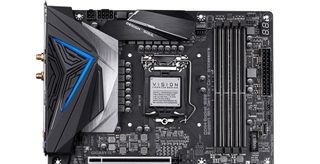
Zooming in on the top half of the board, we’re able to get a closer look at the heatsinks, shrouds, and other business going on. The VRM heatsinks are connected via heatpipes in order to share the load. The left heatsink sports a brushed-aluminum look (as are all the silver/aluminum-colored heatsinks) while the top has a high-gloss black brushed appearance. Between them is a reinforced 8-pin EPS (required) plug and an (optional) 4-pin for powering the CPU.
To the right of the CPU socket are four reinforced DIMM slots capable of running up to 128GB of RAM. Speeds are listed up to DDR4 4400 for this motherboard which is on the lower side of speed support (the Vision G is up to DDR4 5000). Unless you’re benchmarking competitively, this shouldn’t be a problem for most users. The board is designed for creators, and for those types of users, stability is more of a key than ultra-fast RAM speeds/bandwidth support.
Note that due to the primary PCIe slot’s location, it’s difficult to reach the bottom locks for the RAM, as they bump into the video card. Gigabyte should use single-sided locking mechanisms if RAM slots are going to be that close to the GPU.
Wedged between the DRAM slots and top VRM heatsink is the first (of eight) 4-pin fan headers. There are plenty of headers by count. However, the manual doesn’t seem to mention how much power each of these is capable of. To that end, assume they are all 12W/1A to avoid issues.
On the right edge of the board on top, we find the first of four RGB headers. Just below it is the 2-character debug LED, a nice value add for this class of motherboard. Below that is the reinforced 24-pin ATX power plug for the motherboard, two system fan headers, and one of the 2-pin temperature headers. Continuing down the right edge is a front panel USB 3.2 Gen 2 Type-C port and a USB 3.2 Gen 1 header.

Moving on to power delivery, Gigabyte advertises both boards as 12+1-phase VRMs. Power is fed from the EPS connectors to an Intersil ISL69296 12-channel (X+Y+Z=12) controller. This direct power phase design feeds 12 50A Vishay SiC651A DrMOS MOSFETS, providing the CPU up to 600A power. The VRMs ran a bit warm during overclocking but were well within operating parameters. This setup is perfectly capable of running the flagship Intel Core i9-10900K, even when overclocked to 5.2 GHz.

The bottom half of the board contains all your audio, PCIe, and storage bits. On the far left is the audio section, with the Amp-Up audio EMI shield covering up the Realtek ALC1220-VB premium codec. Also visible are several Nichicon audio caps (yellow) and WIMA caps (red). A smart headphone amp automatically detects the impedance of your head-worn audio device and sets it to the proper level. The audio solution here is better here than on many boards, and most will find it more than good enough.
In the middle of the board, we’ll start with the PCIe slots. Here we spy three full-length slots, each using reinforcement to prevent shearing from heavy graphics cards. The top (primary) slot runs up to x16 while the middle slot is x8 and the bottom slot runs at a maximum of x4. This configuration allows for Quad SLI/Crossfire as well as 2-Way SLI and Crossfire. In addition to the full-length slots is an x1 slot that’s fed from the chipset (along with the bottom slot). Note that Gigabyte advertises PCIe 4.0 compatibility in the top slot with Intel’s upcoming Rocket Lake CPUs.
On the M.2 front, there are a total of three sockets on the Vision D, between the double spaced PCIe slots supporting up to 110mm modules. The top and bottom sockets (black heatsinks) run in PCIe mode only while the middle slot rubs both PCIe and SATA devices. Hidden under the bottom M.2 is a Key-E socket populated with the Intel CNVi module for AX201 Wi-Fi. Instead of listing what is disabled as the ports/sockets are used, we’ll leave the image below for clarity. Here an image can do much better than words.

To the right of the socket and chipset heatsink are the six SATA ports. These ports support RAID0, 1, 5 and 10. Just below these ports is a single 6-pin PCIe connector designed to feed the board additional power when using multiple video/expansion cards.
The bottom edge of the board contains a slew of headers, ranging from audio and RGB to fan headers and more. Below is a list of all the headers and buttons ordered from left to right.
● Front panel audio
● 3-pin ARGB
● 4-pin RGB
● TPM header
● LED Demo header
● (2) USB 2.0 headers
● Q-Flash button
● (3) Fan headers
● Front panel header
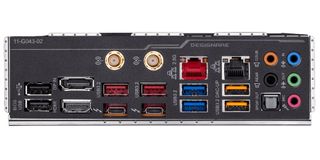
The rear IO on the Vision D is chock full of ports -- especially USB where there are a total of 10. You’ll find two USB 3.2 Gen2 Type-C Thunderbolt ports, two USB 3.2 Gen 2 ports, four USB 3.2 Gen 1 and two USB 2.0 ports. Two of these (they’re orange in color) are DAC-UP ports that Gigabyte says are isolated and low-noise power to help with audio quality. On the video side, outside of the Thunderbolt ports) is an HDMI port and DisplayPort (IN). Last but not least is a 5-pin plus SPDIF audio stack, the two ethernet ports and the Wi-Fi antenna plugs. Creators will love the flexibility this space offers, as you’ll be hard-pressed to find alternatives with Thunderbolt ports at this price point.
Vision G
Starting off with the Vision G’s accessories, we find that what comes with this lesser Vision board is sparse. You get four SATA cables, a driver disk and a manual. It’s enough to get you going, but nothing else. We’re not even going to add bullet points.




Visually, the less-expensive Vision G offers similar styling as the Vision D, with white and brushed-aluminum accents. The PCB is black, yielding a nice contrast between the board and other heatsinks/shrouds. The Vision G also has some grey stenciled patterns that match the exposed parts of the VRM and chipset heatsinks.
Personally, I like the G’s look better than the D, as it is all one color without the black contrasting the brushed aluminum. If you’re looking for integrated RGB lighting though, you’ll have to go elsewhere. That said, the Vision G has a couple of ARGB and RGB headers to add them if needed.
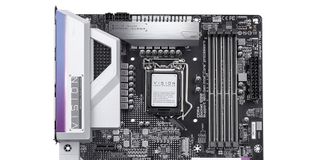
Focusing in on the top half of the board, we notice a white shroud that reaches over the left VRM heatsink, leaving some of what’s below exposed. Underneath the shroud, the VRM heatsinks are connected via a direct-touch heatpipe between the two heatsinks, just like the Vision D. Both VRM heatsink designs effectively cooled the power bits hidden below. Where these heatsinks meet is an 8-pin (required) and 4-pin (optional) EPS connectors that send power to the CPU.
Just to the right of the socket area are four reinforced DIMM slots with locking mechanisms on both sides. Unlike the Vision D, these are easily reached and do not bump into the GPU. The board supports up to 128GB of RAM, with speeds listed up to a stunning DDR4 5000. Of course, your mileage may vary, and reaching those speeds isn’t easy or guaranteed. But this is notably faster than its pricier paternal twin -- the Vision D -- lists by far.
Just above the RAM slots are the first two (of five) 4-pin fan headers. The manual doesn’t list output on these either, so we’ll assume the basic 12W/1A limit on all of them. All fan headers control both PWM and DC controlled devices.
In the upper-right corner are two RGB headers, one 3-pin for ARGB and a 4-pin for RGB strips. In total there are two of each type, with the other two located across the bottom of the motherboard.
Moving down the right edge there’s the 24-pin power connector, a system fan header, a front-panel USB 3.2 Gen1 header and a front-panel USB 3.2 Gen2 Type-C header. In the bottom-right corner is a debug LED, just like the Vision G (4 LEDs, Boot/VGA/RAM/CPU) that displays where the system is in the POST process. If something fails in one of those areas, the LED stays lit letting you know where the issue is.

Power delivery on the Vision G is the same as on the Vision D. Both boards sport 12-phase 50A MOSFETs (Vishay SiC651A) with a 12-channel (Intersil ISL69296) controller. This configuration is plenty capable, as mentioned earlier.
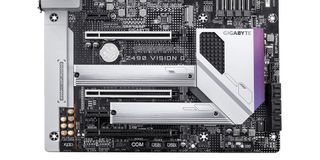
We’ll start on the bottom half of the board with the audio section on the left side. Like the Vision D, the Vision G also uses the premium Realtek ALC1220-VB codec. A plastic shroud covers the Realtek IC but we still see the yellow Nichicon audio caps. What’s missing here compared to the Vision D is the WIMA type audio caps. Otherwise, it’s the same including the smart headphone amp.
Looking at the PCIe slots in the center, we see a slightly different configuration from the Vision D. In this case, there are three full-length slots (two of which are reinforced) and two x1 PCIe slots. The Vision D only had one x1 slot here. The top full-length slot works as x16, with the middle slot working at a maximum x8 (supporting both Nvidia and AMD Quadfire/2-Way SLI). Both slots are sourced from the CPU, while the bottom slot’s lanes come from the chipset and run at PCIe 3.0 x4. What’s good about this slot configuration is the top slot isn’t jammed up against the DRAM slot latches like it is on the Vision D.
Between the slots are two M.2 sockets, both with heatsinks to keep the warm running devices cooler. The top slot (M2P_SB) supports PCIe x4 modules up to 110mm while the second slot (M2A_SB) handles both SATA and PCIe based modules up to 80mm. Both slots’ bandwidth is sourced from the chipset. Due to this, only SATA 1 port is disabled when using an M.2 SATA-based SSD on M2A_SB (the lower socket). Just above the primary PCIe slot is another M.2 socket, this one is PCIe 4.0-capable with the next generation Intel CPU.
To the right of the chipset heatsink are six SATA ports supporting RAID0, 1, 5 and 10. Just above these are two headers for Thunderbolt add-in cards, a 3-pin and 4-pin. Just below the SATA ports are four debug LEDs that light up during the POST process. If one of the four areas (CPU, DRAM, VGA, BOOT) has an issue, the corresponding LED remains lit, letting you know where in the boot process things went wrong.
The bottom edge of the board holds several headers that range from fans and audio to USB and more. Below is the full list, ordered from left to right.
- Front panel audio
- 3-pin ARGB
- 4-pin RGB
- TPM header
- COM port
- (2) USB 2.0 headers
- Q-Flash button
- System fan header
- Front panel
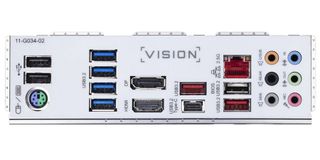
Like the Vision D, the Vision G is chock full of USB ports, again delivering a total of 10. On this board, we find four USB 3.2 Gen2 ports (1x Type-C and 3x Type-A), four USB 3.2 Gen1 ports, and two USB 2.0 ports. Video outputs consist of HDMI and DisplayPort. Other connections include Ethernet (RJ-45), a legacy PS/2 port, and a six-plug analog audio stack. Missing here is the SPDIF output for audio. But otherwise, there are enough ports and connectors for most users.

Joe Shields is a Freelance writer for Tom’s Hardware US. He reviews motherboards.
-
seanzeu Does Gigabyte have an AMD equivalent? For Creators?Reply
Would their x570 Master come close? -
Loadedaxe I bought the D just for Thunderbolt. Works well, but not as fast transferring large files as the TB on my Mac.Reply
Note to those thinking of buying. The M.2 shields do not work for what they are intended. They make SSDs run hotter than with them off. I have 4 different ones, mainly used for storage. My 970 Evo is my boot drive, I also tried the Sabrent Rocket, the Corsair MP510 and the WD SN750, all 1TB drives except the Sabrent (2TB) and all run ~10C higher with the SSD covers on.
Its a decent board, but the drivers for TB on the Windows platform could use some finesse. It should transfer as fast as my 2020 iMac according to Intel, but it is definitely slower. Overall though. Its a good board, running Intel i9-10850k, 32GB DDR4 3600, Sapphire Radeon RX5700XT Nitro+ all wrapped in a Bequiet PureBase 500DX
